Running a business with several branches is exciting, but it comes with unique challenges. The biggest is often making sure customers find the correct address for the location nearest to them.
We have seen many business owners lose potential foot traffic simply because search engines displayed the wrong details. It is frustrating when a loyal customer drives to the wrong side of town because of a bad map listing.
The good news is that you can fix this by helping Google understand your business structure. By adding specific code to your site, you ensure every branch gets the visibility it deserves.
In this guide, we will show you how to add multiple locations schema for a local business in WordPress.
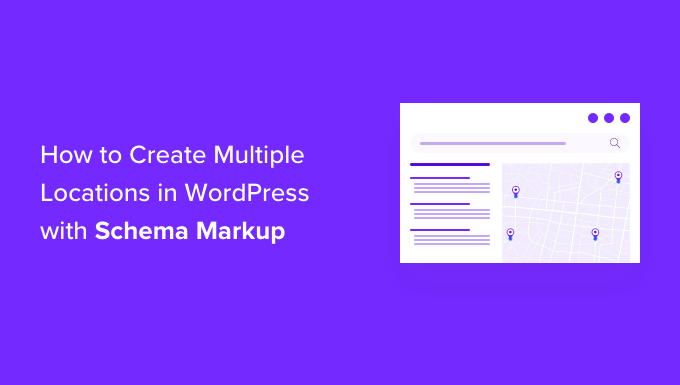
Why Create Local Business Schema Markup for Multiple Locations?
Schema markup is a special code that tells search engines exactly what your content means. Think of it as a translator that helps Google understand your business information better.
When you add this structured data to your WordPress website, search engines can display rich, detailed information about your business directly in search results. This includes everything from your business hours and phone numbers to customer reviews and directions.
For multi-location businesses, schema markup becomes even more powerful. Instead of showing generic search results, you can display specific information for each of your locations, making it easier for customers to find exactly what they need.
Here’s what this looks like in action. When someone searches for ‘McDonald’s locations near me’, Google doesn’t just show a basic website link. Instead, it displays a rich snippet with individual locations, addresses, hours, and an interactive map:

The business impact is significant:
- Each location can rank for its specific area and services
- Rich snippets with maps and business details get more clicks than plain text results
- People see accurate, location-specific information before they visit or call
- When customers have the right information upfront, they’re more likely to become paying customers
Based on our experience helping hundreds of multi-location businesses, properly implemented schema markup consistently leads to noticeable improvements in local search visibility and click-through rates, though results vary depending on industry and competition levels.
Now, let’s walk through exactly how to set up local business schema for multiple locations on your WordPress website.
Creating Multiple Locations Using Schema Markup
The easiest way to set up local business schema markup in WordPress is by using the All in One SEO (AIOSEO) plugin. It’s the best SEO tool for WordPress that’s used by over 3 million website owners and professionals.
AIOSEO removes the need for any technical knowledge or hiring an expert to boost your search engine visibility.
For this tutorial, we’ll be using the AIOSEO Pro license because it includes the Local SEO addon, which is what you need to dominate local business SEO. It also has other powerful features like the redirection manager, advanced sitemap, link assistant, and more.
If you’re on a budget, then you can use the free version of AIOSEO to get started with SEO optimization, but please note that the Multiple Locations feature requires the Pro version.
The first thing you’ll need to do is install and activate the AIOSEO plugin. For more details, please see our guide on how to install a WordPress plugin.
Upon activation, you’ll see the setup wizard. Go ahead and click the ‘Let’s Get Started’ button.
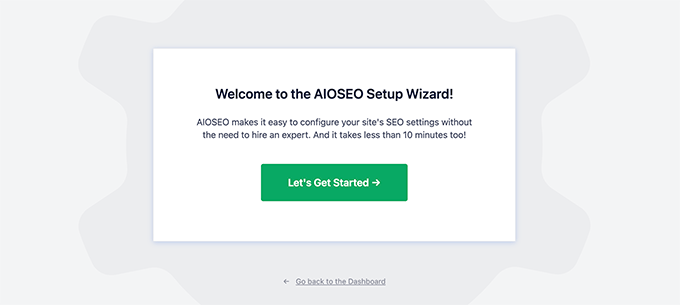
After that, follow the onscreen instructions in the setup wizard to configure the plugin. If you need help, then please see our guide on how to properly set up AIOSEO in WordPress.
Next, you’ll need to head over to All in One SEO » Local SEO from your WordPress dashboard and click the ‘Activate Local SEO’ button.
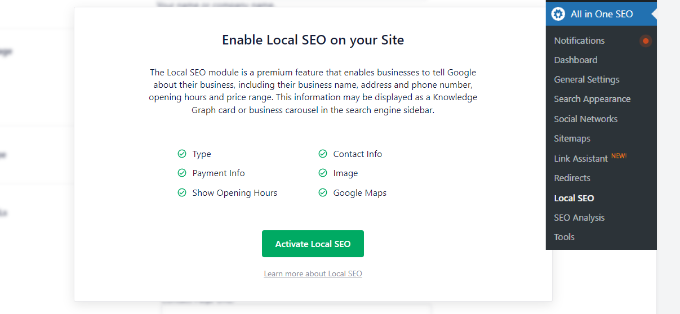
Once the Local SEO addon is active, you’ll see different Location Settings.
Go ahead and click the ‘Multiple Locations’ toggle to enable the option. This will add a new menu item in your WordPress admin sidebar called ‘Locations’, which works similarly to Posts or Pages.
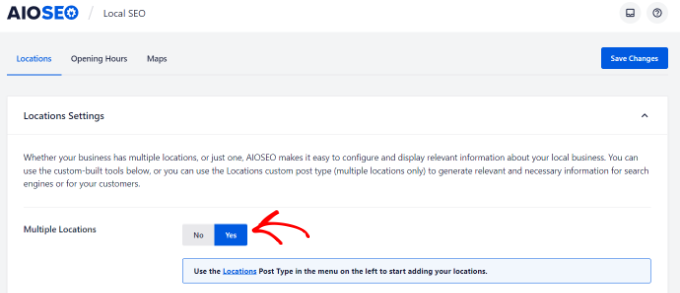
After that, you can scroll down to the ‘Advanced Settings’ section.
Here you can see the permalink settings. This determines the URL structure for your locations. For example, by default, your main list of branches will be found at yourdomain.com/locations/.
If you wish to use a custom link, then simply check the ‘Use custom slug’ box and enter your permalink URL structure.
Next, you can also switch on the ‘Enhanced Search’ option, which will include your business locations in your WordPress site search results.
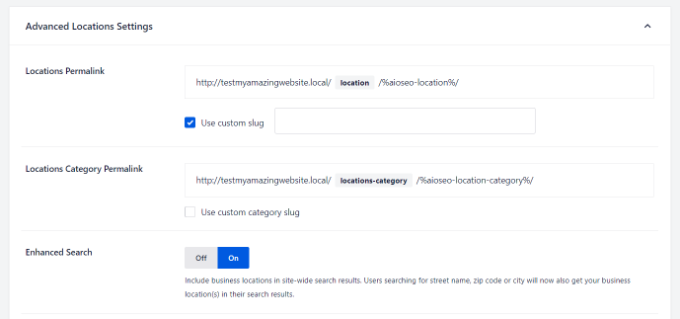
When you’re done, don’t forget to click the ‘Save Changes’ button.
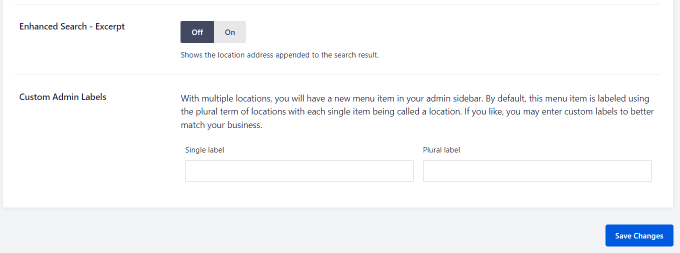
Next, you can go to the ‘Opening Hours’ tab and configure the times for your local businesses.
By default, the ‘Show Opening Hours’ option will be set to Yes. If you don’t want to show opening hours, then simply click the toggle to No.
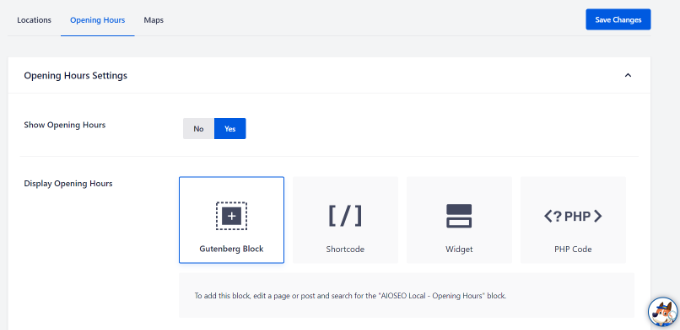
After that, you can scroll down and change the labels for when your business is open or closed.
There are also options to change the opening and closing timings for specific days or set it to open 24/7.
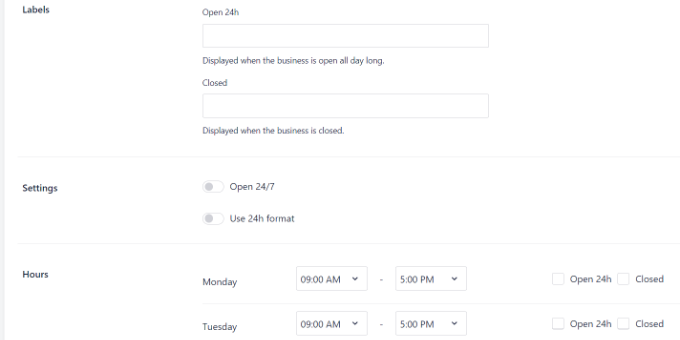
Note: The opening hours will be used across all the locations you add in WordPress. However, you can disable them for specific locations in the content editor.
AIOSEO also lets you integrate Google Maps with your WordPress website to display an interactive map of your location for visitors. For more details, you can see our guide on how to add Google Maps in WordPress.
Next, you’ll need to add your multiple business locations in WordPress.
Adding Multiple Business Locations in WordPress
When you enable the Multiple Locations option in AIOSEO, a new ‘Locations’ option will appear in your WordPress admin panel.
To add your local business locations, simply go to Locations » Add New from your WordPress dashboard.
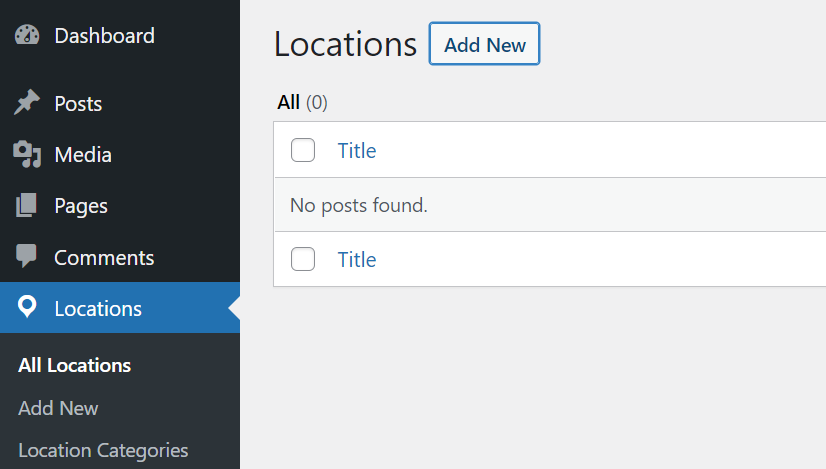
Next, you’ll need to add your location details in the WordPress content editor. Here you can add a title for your business location, which can be the location name.
Under the title, you can add more details or descriptions about your location. You can also create location categories from the settings panel on your right.
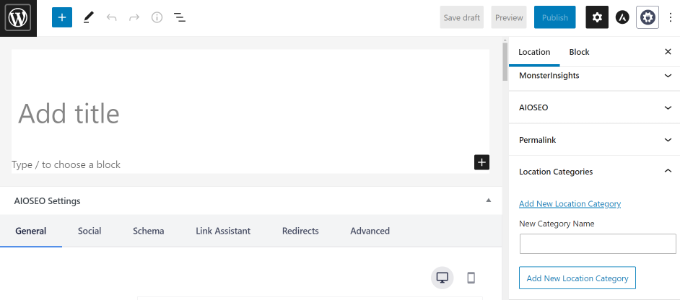
After that, simply scroll down to the AIOSEO Local Business metabox.
In the ‘Business Info’ section, you can add your business name, select a business type (industry), add an image, enter the address for your location, business phone, payment info, the area served, and more.
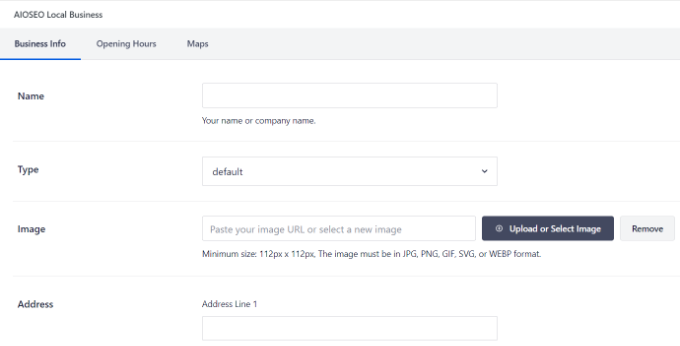
Next, you can switch to the ‘Opening Hours’ tab under the AIOSEO Local Business metabox.
AIOSEO will use the default settings automatically. However, you can disable the ‘Use Defaults’ option and then configure the opening and closing hours for your local business.
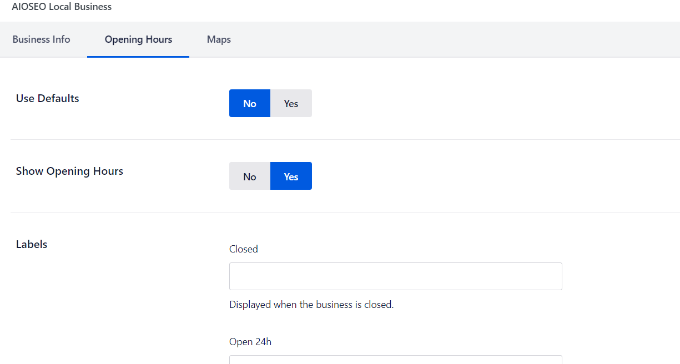
Next, you can go to the ‘Maps’ tab and configure how your map looks.
Note: For the map to display correctly, ensure you have entered a valid Google Maps API key in the main Local SEO settings menu.
For instance, you can change the map style and upload a custom marker to pin your location on the map.
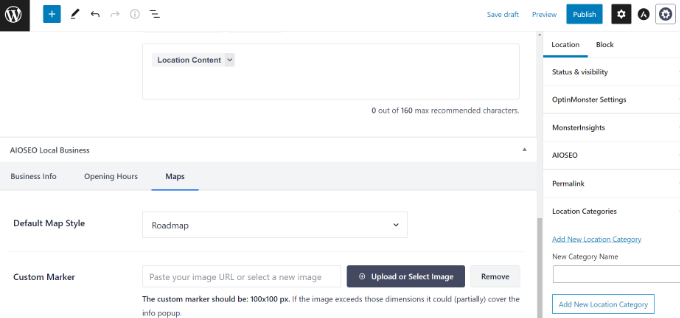
When you’re done, go ahead and publish your location page.
We recommend testing your new URL with Google’s Rich Results Test tool to confirm the schema code is working correctly.
Now, you can simply repeat this process for other locations you want to add to your WordPress website.
After you’ve set up local business schema for your multiple locations, you can also use geotargeting to display personalized content on your website based on your visitors’ geographical locations. To learn more, check out this guide to geotargeting.
Video Tutorial
Frequently Asked Questions About Local Business Schema
We often hear from readers who want to improve their local SEO but find the technical terms confusing. Here are answers to some of the most common questions we get about setting up multiple locations in WordPress.
1. Do I really need schema markup if I have a Google Business Profile?
Yes, you should have both. Your Google Business Profile controls what appears on Google Maps, while schema markup helps search engines understand the content on your actual website. Using them together gives you the best chance of ranking higher in local search results.
2. Can I use multiple location schema for a service-area business?
Absolutely. If you run a service business like plumbing, or a ‘hybrid’ business like a pizza place that delivers, you can define the ‘Area Served’ in your schema settings. This tells Google which neighborhoods you cover.
3. Will adding this schema guarantee my business shows up in the ‘Local Pack’?
While no SEO tool can guarantee a specific ranking, adding proper schema markup significantly improves your odds. It provides Google with verified data about your locations, which makes the search engine more confident in displaying your business in the featured map section.
4. Can I add schema markup manually without a plugin?
You can add schema manually using code, but it is risky for beginners. One small error in the JSON-LD code can break the markup for the whole page. Using a plugin like AIOSEO automates the process and ensures the code is formatted correctly for Google standards.
Additional Resources
Now that you have set up multiple location schemas, you may want to explore these other guides to boost your local SEO and site performance:
- How to Add Google Maps in WordPress (The Right Way)
- How to Add Schema Markup in WordPress and WooCommerce
- Ultimate Guide to Geolocation Targeting in WordPress
- How to Improve Organic Click Through Rate (CTR) in WordPress
- The Ultimate WordPress SEO Guide for Beginners (Step by Step)
If you liked this article, then please subscribe to our YouTube Channel for WordPress video tutorials. You can also find us on Twitter and Facebook.





Have a question or suggestion? Please leave a comment to start the discussion.